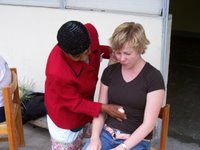San Martín Huamelulpan
This weekend our group ventured to San Martín Huamelulpan, which is approximately 2.5 hours northwest of Oaxaca. We left the city bright and early on Saturday morning so we would have most of the day to explore the area and meet with some of the community members. Upon arrival, we were greeted by two women who were representatives of the community´s local museum. It was interesting to see how much of an impact our presence had on this little town. The population of San Martín is approximately 1600 individuals (if I remember correctly). However, upon entering the city, one would be inclined to believe there are fewer. Many of the homes stretch up into the surrounding hills, creating the illusion that there really isn´t a city at all. The environment there was a great contrast to the congestion and noise I´ve become accustomed to in the city. Although we only met a handfull of people, each person went to great lengths to show his or her hospitality, which was much appreciated.
We covered a lot of ground in a day and a half. By far, one of the most interesting experiences I had this weekend was my limpia from the local curandera. Limpia is a long standing healing tradition that is still prevalent in a number of communities and among many families today. Often children receive limpias when parents or family members suspect someone has given them mal ojo or (evil eye). Unlike in the United States, it is not acceptable to fawn over a pretty child or make comments to the parents about how adorable or cute he or she may be. People generally consider this a form of envy, which can be a hazard to the child´s health.
The limpia process is somewhat complex and I don´t understand all of the steps (especially since the curandera was whispering in Spanish). However, the process went something like this: While I was sitting in a chair with my eyes closed, the curandera took a free range chicken egg and doused it in mezcal, then proceeded to rub it all over my body. It is thought that the egg can pick up energy from each person, which then impacts the reading of the egg once it is cracked into a glass cup. Before the egg is cracked, a number of local herbs and healing plants were tied together and wiped all over the top of my head, arms, torso and legs. This step serves as the limpia, or cleaning. Afterward, I opened my eyes and watched as the curandera cracked the egg into the glass cup. She told me that I was sick because I walk in dirty streets every day and prescribed a mezcal steam bath to cure me of this affliction. When she cracked my egg, the yolk did not rise to the top, which is why I was told I was sick. My friend Rachael underwent the same process and had very different results. Her egg yolk rose to the top of the glass, indicating she was healthy. The curandera asked her if she had a relatively easy and clean walk every day and she responded that she indeed did. Where as I walk through the grimy part of town each day, in muddy streets and through broken sidewalks, Rachael supposedly has a much easier route.
Perhaps the curandera´s analyses of our broken eggs were metaphorical. I can´t really say, as she did not stay long enough for us to ask many questions. But regardless of what any of us believes about this experience, it was wonderfully insightful to undergo a different form of healing (especially one that is so strongly embedded within the culture).
If you are thinking, "This ritual must only be used by people who live in rural Mexico," that is definitely not the case. A number of people I have spoken to in the city either have experienced a limpia or know families who perform limpias to protect and heal their loved ones. Natalie lives with a family who regularly uses this tradition to predict whether their one and a half year old granddaughter has been receiving too much unwanted attention. Ruby, a particularly pretty little girl, often receives a lot of stares because she is very light skinned (this is a quality that is somewhat exotic in Oaxaca). Normally a very happy go lucky baby, when Ruby cries, her grandparents perform a limpia to calm her. Though I have not been there to witness the process, Natalie informs me that Ruby generally regresses back to her usual behavior after this is done. While I can´t explain how the limpia actually works or the impact it has, I can appreciate the history behind this healing ritual and respect the faith people have in this act.
Aside from my limpia, I also had a chance to visit some of the local archaelogical ruins. Much of San Martín Huamelulpan remains unearthed, as there are over 10,000 archaeological sites and not enough archaeologists or funding to complete all of the work. This photo was taken on the church grounds which are adjacent to a large set of ruins that were onced used by priests and nobles for religious rituals and gatherings.
